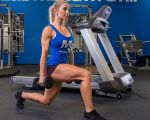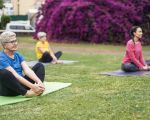- Why Strength Training is Important for Home Use
- Top Strength Training Exercises for Home
- How to Create a Home Strength Training Routine
- Benefits of Strength Training at Home
- Tips for Maximizing Your Home Strength Training
Why Strength Training is Important for Home Use
Strength training is an essential component of a well-rounded fitness routine, but many people associate it with a gym environment. However, incorporating strength training exercises for home use can offer just as many benefits, if not more, than a traditional gym session. With the right exercises and equipment, you can target and strengthen various muscle groups from the comfort of your own home, saving both time and money on gym memberships.
One of the biggest advantages of strength training at home is convenience. You can work out whenever it fits your schedule, without having to commute or worry about crowded gym spaces. Additionally, home workouts can be tailored to your specific fitness goals, whether that’s building muscle, toning, or improving overall strength. Home strength training also offers flexibility, allowing you to adjust your routine as you progress, and avoid the distractions or pressure that sometimes come with public gym spaces.
Top Strength Training Exercises for Home
When considering strength training exercises for home use, it's essential to include a variety of moves that target different muscle groups. Below are some effective exercises that require minimal or no equipment, making them perfect for home workouts:
1. Bodyweight Squats
Squats are one of the best exercises to target your lower body, including your quads, hamstrings, and glutes. Bodyweight squats are incredibly effective for building strength and can be performed anywhere in your home. Simply stand with your feet shoulder-width apart, lower your hips back and down, keeping your chest up, and then rise back up to standing. As you get stronger, you can add variations such as jump squats or hold a weight like a dumbbell or kettlebell to increase intensity.
2. Push-Ups
Push-ups are a classic strength training exercise that targets the chest, shoulders, and triceps. There are several variations to choose from, including standard push-ups, incline push-ups (placing your hands on an elevated surface), or decline push-ups (placing your feet on an elevated surface). If you're new to push-ups, start with wall push-ups or knee push-ups to build strength before progressing to the full version.
3. Plank
The plank is a great core-strengthening exercise that also engages the shoulders, back, and glutes. To perform a plank, get into a push-up position, but lower yourself onto your forearms, keeping your body in a straight line from head to heels. Hold this position for as long as you can while maintaining good form. Planks help improve overall stability and posture, and can be made more challenging by adding side planks or plank leg lifts.
4. Dumbbell Rows
If you have a set of dumbbells, dumbbell rows are an excellent way to target your upper back, biceps, and shoulders. Place one knee and hand on a bench or sturdy surface, keeping your back flat, and row the dumbbell towards your torso. Alternate arms, or use both at once for a more intense workout. Dumbbell rows can help improve posture and prevent back pain, especially for those who spend long hours sitting at a desk.
5. Lunges
Lunges are a fantastic exercise for your lower body, particularly your glutes, quads, and hamstrings. Step forward with one leg, lowering your hips until both knees are bent at a 90-degree angle. Push back up to the starting position and repeat with the other leg. To increase intensity, hold dumbbells in each hand or try jump lunges for a more challenging move. Lunges also improve balance and stability, which are essential for overall fitness.
How to Create a Home Strength Training Routine
Creating an effective home strength training routine requires careful planning to ensure that you target all of your major muscle groups and progressively increase the intensity as you get stronger. Here are some key tips for designing a balanced and sustainable home workout routine:
1. Set Clear Goals
Before starting any workout program, it’s important to have clear fitness goals in mind. Are you looking to build muscle mass, tone your body, improve endurance, or simply maintain general fitness? Knowing your goals will help you select the right exercises and determine the frequency, intensity, and duration of your workouts.
2. Choose Compound Movements
When training at home, compound exercises are incredibly effective because they work multiple muscle groups at once. Incorporate exercises like squats, push-ups, and lunges into your routine, as they will engage several muscles and help you get the most out of your workout in a short amount of time.
3. Include Rest and Recovery Days
Strength training places a significant load on your muscles, so it's essential to include rest and recovery days in your routine. Typically, you should aim for at least two or three days of strength training per week, with rest days in between. On rest days, consider incorporating light cardio or flexibility exercises to aid in recovery.
4. Gradually Increase Intensity
To continue seeing progress, it’s important to gradually increase the intensity of your workouts. This can be achieved by adding more weight, increasing the number of sets or reps, or trying more advanced variations of the exercises. Progressive overload is the key to building muscle and strength, so don’t be afraid to challenge yourself as you become stronger.
Benefits of Strength Training at Home
Strength training at home offers numerous advantages that make it an attractive option for many individuals. Here are some of the key benefits of incorporating home-based strength training exercises into your fitness routine:
1. Convenience
One of the most significant benefits of home strength training is the convenience. You don’t need to worry about commuting to a gym, dealing with crowded spaces, or scheduling time around gym hours. You can work out whenever fits your schedule and at your own pace, without the added pressure of others watching you.
2. Cost-Effective
Home strength training eliminates the need for a costly gym membership or expensive personal training sessions. With a few basic pieces of equipment, such as dumbbells or resistance bands, you can perform a wide variety of exercises that target all major muscle groups. Over time, this can save you a substantial amount of money compared to a gym membership.
3. Privacy
Some individuals feel self-conscious about working out in a gym setting, especially if they are new to strength training. Training at home allows you to exercise in the privacy of your own space, free from distractions or judgment. This can boost confidence and allow you to focus more on your workout.
4. Flexibility
Home strength training offers the flexibility to create your own workout schedule. You can fit in a quick session before work, after school, or even during your lunch break. This level of flexibility is often a key factor in helping individuals stick to a regular fitness routine.
Tips for Maximizing Your Home Strength Training
To get the most out of your home strength training routine, consider the following tips:
- Warm Up and Cool Down: Always take the time to properly warm up before you start your workout and cool down afterward. This helps prevent injuries and promotes muscle recovery.
- Track Your Progress: Keep a log of your workouts to track improvements in strength and endurance. This will help you stay motivated and ensure that you’re progressing toward your fitness goals.
- Mix Up Your Routine: To prevent boredom and ensure that your muscles continue to grow, mix up your exercises and try new variations regularly.
- Stay Consistent: Consistency is key when it comes to strength training. Stick to your routine and challenge yourself to stay disciplined over time.
For high-quality equipment and expert tips to enhance your strength training journey, check out Fitness for a wide range of products designed to support your fitness goals.








